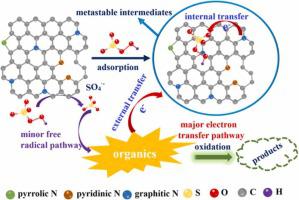Journal of Hazardous Materials ( IF 12.2 ) Pub Date : 2021-10-24 , DOI: 10.1016/j.jhazmat.2021.127568 Mengfei He 1 , Peng Zhao 1 , Ran Duan 1 , Shengjun Xu 2 , Gong Cheng 3 , Mengjia Li 4 , Shuanglong Ma 1

|
In this study, chitosan, a low-price and easily obtainable natural polymerized sugar containing abundant nitrogen element, was employed as a precursor for preparing hierarchically porous carbon (PC) to activate peroxymonosulfate (PMS). The PC fabricated at 800 °C obtained the optimum catalytic performance with complete removal of p-hydroxybenzoic acid (HBA) in 30 min. The selective degradation toward phenolic pollutants with different substituent groups and the resistance over the interference of typical anions and natural organic matter implied a non-radical pathway contributed most for HBA degradation. The investigation of structure-activity relationship suggested a positive linear correlation between graphitic N content and HBA removal. The chemical quenching experiment and electron paramagnetic resonance (EPR) excluded the crucial role of radicals and 1O2. Solid evidence based on electrochemical techniques demonstrated the essential contribution of electron transfer pathway achieved by three successive processes including the first close adsorption of PMS by PC800 to form metastable intermediates, then an internal electron transfer from active graphitic N to PMS within metastable intermediates and finally external electron transfer from HBA to metastable intermediates. This study provided insightful mechanism understanding of a promising organics elimination strategy by PMS activation through N-doped carbonaceous materials utilizing chitosan as a simultaneous carbon and nitrogen precursor.
中文翻译:

内源性氮掺杂碳质材料和过氧单硫酸盐体系降解酚类污染物的电子传递途径研究
在这项研究中,壳聚糖是一种价格低廉且易于获得的含有丰富氮元素的天然聚合糖,被用作制备分级多孔碳(PC)以激活过氧单硫酸盐(PMS)的前体。在 800 °C 制备的 PC 获得了最佳催化性能,在 30 分钟内完全去除了对羟基苯甲酸 (HBA)。对具有不同取代基的酚类污染物的选择性降解以及对典型阴离子和天然有机物干扰的抵抗力表明非自由基途径对HBA降解的贡献最大。对构效关系的研究表明,石墨 N 含量与 HBA 去除之间呈正线性相关。1 O 2。基于电化学技术的可靠证据证明了电子转移途径的重要贡献是通过三个连续过程实现的,包括 PC800 对 PMS 的第一次紧密吸附以形成亚稳态中间体,然后在亚稳态中间体中从活性石墨 N 到 PMS 的内部电子转移,最后是外部电子转移。电子从 HBA 转移到亚稳态中间体。该研究通过利用壳聚糖作为同时碳和氮前体的 N 掺杂碳质材料通过 PMS 活化来消除有机物的有前景的策略提供了深刻的机制理解。











































 京公网安备 11010802027423号
京公网安备 11010802027423号